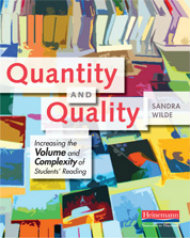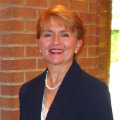Quantity and Quality: Increasing Volume & Complexity of Students’ Reading
Quantity and Quality: Increasing the Volume and Complexity of Students’ Reading
By Sandra Wilde
(Publisher: Heinemann, 2013 – Learn more)
It is refreshing to read a professional book that addresses a truly basic skill all students need: the ability to read and to read well. Author Sandra Wilde begins Chapter One noting the premise of her book: to encourage educators to increase the quantity of books students read while providing students the means to mature as readers by increasing the complexity of the books they read. She goes on to summarize 10 Core Principles she believes can increase quantity and quality.
As Wilde states, reading is the “secret to academic achievement” for students. Educators will concur. We need to get students reading and, in turn, we need to make sure students mature as readers starting in first grade and become sophisticated readers by high school graduation so they are well prepared to tackle the world beyond their K-12 years.

Wilde stresses that “…there can be nothing more important than putting reading at the center of what goes on in your classroom.” Her book provides the reasoning and strategies educators need to not only “teach students to read” but “ensure that they do read.”
In Chapter One Wilde includes recommendations for the core principles she believes to be the basis of developing students into mature readers. The principles may be intended for students, but they certainly apply to readers of all ages…
- Read a lot and set personal goals.
- Read from a variety of genres, topics, etc.
- Grow as a reader by reading more challenging books.
- Make time to read during the school day.
- Help students become smarter readers through our teaching, conferences, and conversations with students.
- Keep a record of what books they read.
Crediting Stephen D. Krashen for his research on reading, Wilde concludes her first chapter with some “big ideas” to increase the volume and complexity of what students read. Wilde points out the correlation between how much students read and their reading achievement. She also states that students who are readers are better writers; their vocabulary expands; they learn content; and they learn about life through the experiences they have through books.
Wilde notes that reading is an important learning skill in all areas of the curriculum, and drawing on the research of others, she shares reasonable reading goals for elementary, middle, and high school students, emphasizing how many pages or books a student reads. However, she is adamant that educators should never make “quantity” an explicit expectation. Instead, goals should be seen as a means of encouragement as teachers urge kids to “seize the time” to read whenever it presents itself.
Promoting complexity
How should we measure reading growth? Wilde recommends three components to consider when working to increase reading complexity for students:
- Sentences should get longer and more complicated;
- Vocabulary should get more difficult; and
- Stories and themes should vary in complexity.
Asserting it is best not to depend on formulas to track students’ reading maturity, Wilde proposes that educators encourage students to think deeper when selecting books by considering general ranges: “personal interest, length of the book, subject matter, and many other individual choices are far more important than a precise level.”
The first three chapters of Wilde’s book are written to support the reasons “why” it is vital students read widely and experience growth in their reading. In the next five chapters, she addresses various “how-to” approaches to ensure students do not “miss out on exposure to adequate numbers of books.” Wilde goes so far as to suggest students should read up to a 1,000 books by the time they graduate from high school.
Class libraries
To accomplish this, Wilde recommends educators develop a classroom library that accommodates a range of readers, provides a mix of literary and popular books, and varies in topics, genre, etc. She notes the need to pay attention to the condition and organization of the books and their accessibility to students. She also recommends keeping a record of books in the classroom library, including developing checkout procedures.
Once a class library is prepared, educators can turn to Wilde’s book to find details on how to encourage students to “read more books, read harder books,” starting the first week of school. Wilde explains how to make each day a reading day. Chapter Five is a wealth of information on how to go about fostering reading participation. The author describes conferencing with students to determine reading proficiency and interests, utilizing reading interest inventories, and the like. What is most important, Wilde maintains, is providing time for students to read in class.
Wilde also provides information on ways to match students to books and how to inspire them to develop a community of readers. She includes a chapter that addresses the needs of English language learners, struggling readers, beginning readers, and reluctant readers. She details how to teach and what to teach to support all students’ maturity as readers. Also included in her book are ideas on efficient ways to document the volume of student reading and growth in student reading ability.
A recognized expert in the field of literacy instruction, Sandra Wilde provides a book with action-oriented solutions to improving students’ reading growth. The best part of the book is that Wilde shares her expertise in straightforward, sound ways that will benefit students and educators alike.
Dr. Mary Long is the Teacher-Librarian at McMillen High School (Plano ISD) in Murphy, TX where she also serves as New Teacher Mentor-Liaison, Campus Moderator-Webmaster, PTSA Campus Representative, and Cultural Competency- Campus Trainer.































